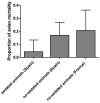Sedation of Wild Pyrenean Capercaillie (Tetrao urogallus aquitanicus) Using Intramuscular Midazolam
- PMID: 35883318
- PMCID: PMC9312258
- DOI: 10.3390/ani12141773
Sedation of Wild Pyrenean Capercaillie (Tetrao urogallus aquitanicus) Using Intramuscular Midazolam
Abstract
Global Positioning System (GPS) tracking offers key information in the study of movement ecology of threatened species. Nevertheless, the placement of GPS devices requires animal capture and handling, which may represent a challenge to the individual's survival after release, mainly due to capture myopathy. The Pyrenean Capercaillie (Tetrao urogallus aquitanicus) is a threatened galliform especially sensitive to handling, extremely elusive, and challenging to capture. Our goal was to adapt a sedation protocol for Pyrenean Capercaillies undergoing GPS tagging, in order to increase their welfare and safety during the procedure. From 2018 to 2021, 23 wild Pyrenean Capercaillies were captured and sedated for GPS tagging as part of a European conservation project of emblematic Pyrenean avian species. The birds received intramuscular (IM) sedation with midazolam (ranging from 1.9 mg/kg to 8.08 mg/kg) and were handled for 20 to 40 min. Sedation was reversed with flumazenil (0.1 mg/mL IM). The sedated capercaillies were less responsive to stimuli (i.e., closed eyes and recumbency), showing discrete to no response to handling (i.e., placement of the GPS device, physical examination, cloacal temperature measurement, or reflex tests). Such response was compared in birds with sedation doses above and below the average dose (5.17 mg/kg). Only one clinical sign showed statistically significant differences between the two groups ("open-mouth breathing" sign, p = 0.02). A mortality rate of 4.35% was registered (one individual died during handling). Sedation facilitated the handling of the birds and faster interventions in the field, without increasing mortality when compared to handling without sedation. Therefore, sedation was shown to be a useful tool to reduce stress related to capture and handling of the threatened Pyrenean Capercaillie.
Keywords: GPS tracking; Galliformes; capture myopathy; conservation; flumazenil; movement ecology.
Conflict of interest statement
The authors declare no conflict of interest.
Figures




References
-
- BirdLife International . Office for Official Publications of the European Communities; Luxembourg: 2015. [(accessed on 29 April 2022)]. European Red List of Birds. Available online: http://datazone.birdlife.org/userfiles/file/Species/erlob/supplementaryp....
-
- Canut J., Garcia-Ferrer D., Afonso-Jordana I. Catalan Breeding Bird Atlas. Distribution and Abundance 2015–2018 and Change since 1980, Cossetània Editions. Cossetània and ICO; Barcelona, Spain: 2021. Pyrenean capercaillie (Tetrao urogallus) pp. 112–113.
-
- Bal G., Bacon L., Ménoni E., Calenge C., Millon A., Besnard A. Modélisation De la Dynamique Du Grand Tétras Des Pyrénées Françaises Pour Sa Gestion Adaptative. Office Français de la Biodiversité, Techical Report Muséum national d’Histoire naturelle (MNHN) et OFB; 2021. [(accessed on 19 April 2022)]. p. 35. Available online: https://www.researchgate.net/publication/354150226_Modelisation_de_la_dy....
-
- Moss R., Oswald J. Climate change and breeding success: Decline of the capercaillie in Scotland. J. Anim. Ecol. 2001;70:47–61. doi: 10.1046/j.1365-2656.2001.00473.x. - DOI
-
- Bañuelos M.J., Quevedo M., Obeso J.R. Habitat partitioning in endangered Cantabrian Capercaillie Tetrao urogallus cantabricus. J. Ornithol. 2004;149:245–252. doi: 10.1007/s10336-007-0267-5. - DOI
LinkOut - more resources
Full Text Sources

